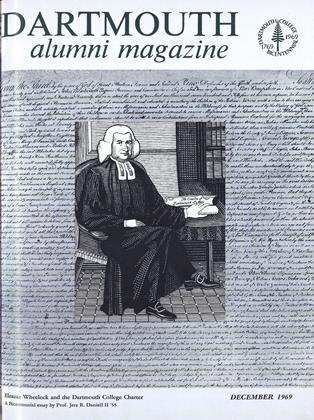Educational television ordinarily does not try to cover the daily local news, nor does it attract a mass audience. But at 7 p.m. on weekdays San Franciscans by the thousands tune in on Station KQED (Channel 9) for an hour-long program called Newsroom. What they watch is a typical newsroom with reporters seated around a U-shaped table; the man in "the slot" is MELVIN S. WAX '40, executive editor, who guides his staff in a lively, unorthodox review of the day's news.
KQED got into local news when San Francisco had a ten-week newspaper strike early in 1968. Mel Wax, who had left the Chronicle the year before to become KQED's Public Affairs Director, set up a "Newspaper of the Air" and invited reporters from the idle papers to tell their stories instead of writing them. The program was on from 7 to 8 each evening, seven days a week. Right from the start, this news show had a fresh and freewheeling approach; instead of announcers merely reading the news here were reporters "dealing with matters about which they were informed and which they had covered personally. And it was fluid group performance, with questions and much give-and-take.
After the strike was settled, KQED continued with a Sunday review of the week, but the success of the innovative "Newspaper of the Air" spurred Wax and his colleagues into the effort to make the nightly news show a regular offering. With the help of a Ford Foundation grant, Newsroom was launched in September 1968. Another Ford grant of $748,000 is currently aiding the show in its second year. Mel Wax heads a staff of eleven journalists who have switched to TV from newspapers and magazines because they prefer the program's way of reporting the news. Included are specialists in City Hall, education, science, and urban affairs, and there is even an editorial cartoonist. Working with the staff are seven apprentices from minority groups who are in training for jobs in television news.
"We try to tell not only what happened but why it happened and what it means to the public," Mel Wax explained about the program's purpose. "Our emphasis is local, but we do have commentary on foreign news and if national news warrants it, we do not hesitate to bring in an expert to explain it. For example, we have a lawyer tell what a Supreme Court decision means.
"Good reporters are the key to the success of our kind of program, and we think we have the best local news team on TV," he continued. "We skip crime, sports, fires, and accidents, and concentrate on events of substance, especially those affecting the community. We're pleased to see that our pilot program has led other educational stations to try it, and we seem to be having some influence on commercial stations too — we now have 'News Watch' and 'News Beat' in San Francisco."
A recent honor in which KQED and Mel Wax's public affairs department take special pride is the winning of a 1968-69 Alfred I. duPont-Columbia University Award for outstanding local coverage of the 1968 political campaigns. This award, comparable to a Pulitzer, was won in competition with both commercial and educational stations throughout the country.
Mel Wax has been a reporter or editor ever since graduation from Dartmouth. He was with the Claremont (N. H.) Daily Eagle and the Rutland Herald before winning a Nieman Fellowship at Harvard. He returned to the Eagle as managing editor in 1950 and spent two years with the Chicago Sun-Times, 1955-57, before beginning a ten-year period with the San Francisco Chronicle as reporter and urban affairs editor. A weekly program for KQED led to the station's asking him to join them full-time as Public Affairs Director in August 1967. Mel is married to the former Charlotte Speight of Hanover, whose father was a Dartmouth professor. They live in Sausalito, where a citizens' fight to keep open a stretch of waterfront led to Mel's being elected Mayor in 1966.
 View Full Issue
View Full Issue
More From This Issue
-
 Feature
FeatureEleazar Wheelock and the Dartmouth College Charter
December 1969 By JERE R. DANIELL II '55, -
 Feature
FeatureEleazar: The Man Behind the Myth
December 1969 By John Hurd '21 -
 Feature
FeatureTHE WHEELOCK SUCCESSION
December 1969 -
 Feature
FeatureMovie Producer
December 1969 By HAROLD BRAMAN '21 -
 Article
ArticleCharter of Dartmouth College
December 1969 -
 Article
ArticleWith the Big Green Teams
December 1969
Features
-
 Feature
FeatureJODIE MACK
Nov - Dec -
 Feature
FeatureDead Aim
JANUARY | FEBRUARY 2018 By BILL GIFFORD ’88 -
 Feature
FeatureThe Case of the Prodigal Son
MARCH • 1986 By Bruce Ducker '60 -
 Cover Story
Cover StoryOur Man in Egypt
Nov/Dec 2006 By DIRK OLIN ’81 -
 Feature
FeatureMILITARY POWER: THE FADING PERSUADER
OCTOBER 1966 By LIEUTENANT GENERAL JAMES M. GAVIN -
 Feature
FeatureWhy an Engineer Needs English Lit
May/June 2003 By SAMUEL C. FLORMAN ’46, TH’46

